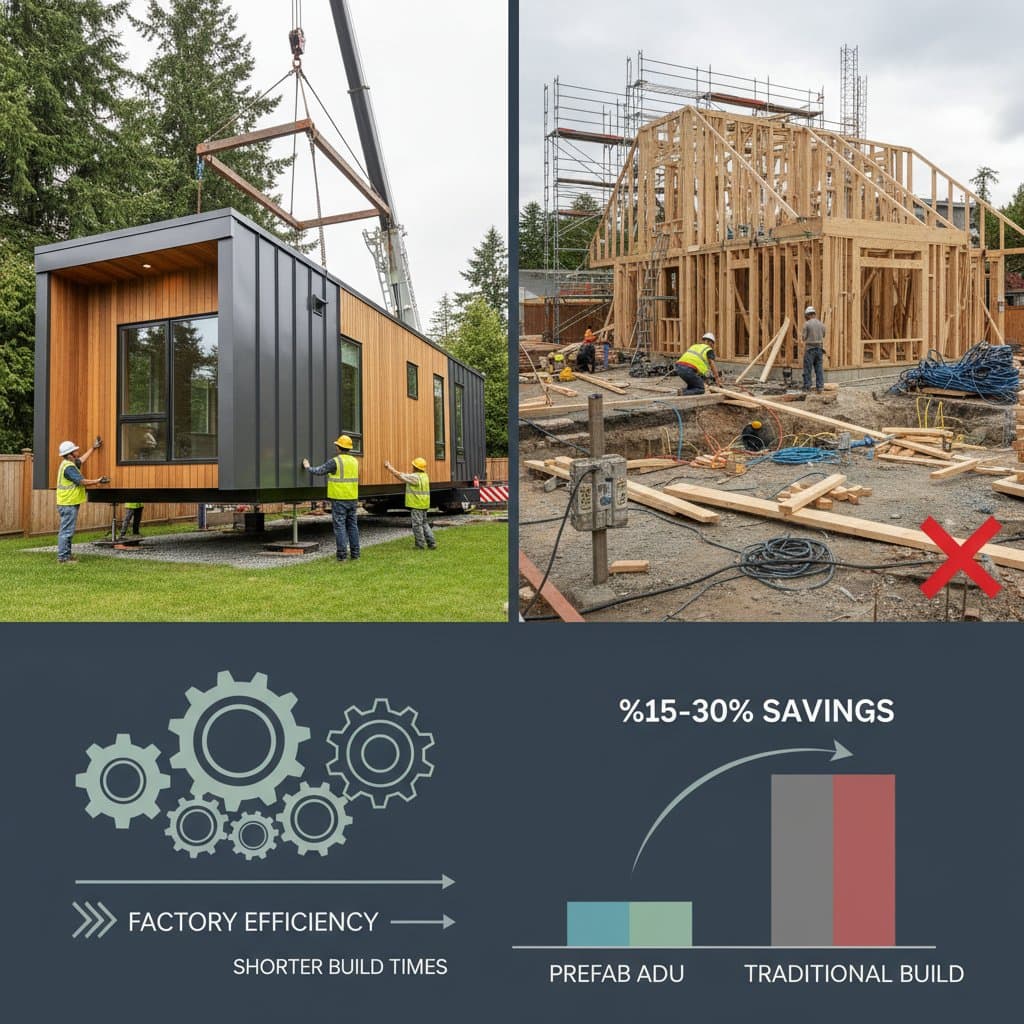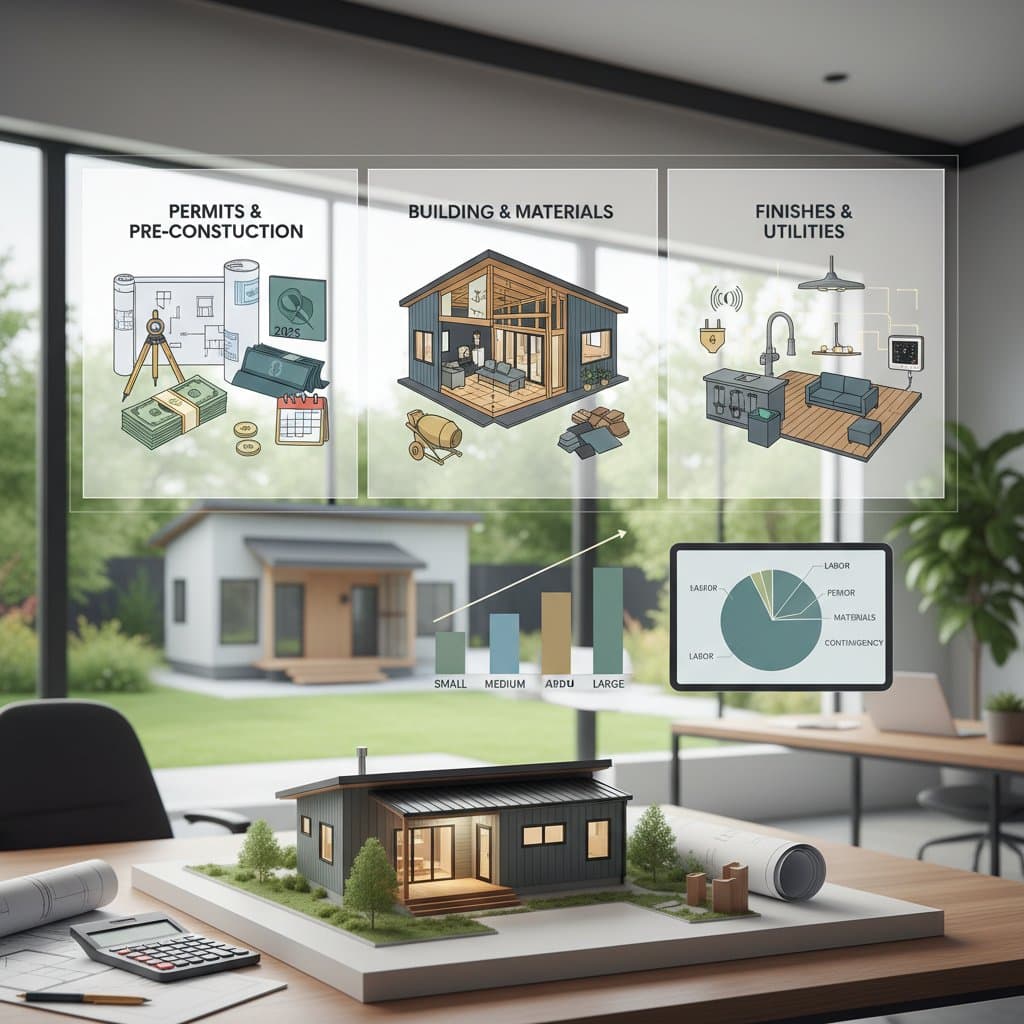Prefab vs Site-Built ADU Costs: 2025 Insights
Quick Overview
A prefabricated accessory dwelling unit, known as a prefab ADU, undergoes construction off-site in a controlled factory environment before delivery to the property in finished or near-finished form. In contrast, a site-built ADU involves complete construction directly on the property, starting from the foundation. Prefab ADUs generally complete installation in weeks rather than months, with upfront costs ranging from $70,000 to $250,000 depending on size and features. Site-built ADUs, however, provide unlimited customization opportunities at a higher price point of $150,000 to $400,000, influenced by labor, materials, and local regulations. Both approaches demand meticulous planning to navigate financial risks and construction complexities effectively.
Homeowners benefit from prefab options when timelines tighten or budgets constrain, as these units minimize on-site disruption and weather delays. Site-built projects suit those seeking seamless integration with existing architecture or unique layouts that prefab modules cannot accommodate. Understanding these trade-offs early guides decisions toward a structure that enhances property value while meeting personal needs.
Step-by-Step Guide to Building an ADU
1. Assess Your Property Suitability
Begin by measuring the yard space available for the ADU, accounting for local setback requirements that dictate minimum distances from property lines. Evaluate terrain features such as slopes, soil drainage, and access routes for heavy equipment like cranes or delivery trucks. For prefab selections, confirm sufficient clearance for module placement and lifting operations.
Document these measurements and site conditions in a simple sketch or photo log to share with potential builders. This initial evaluation prevents costly surprises during permitting or construction phases.
2. Verify Zoning and Obtain Permits
Contact your local planning department to review current ADU ordinances, including allowable sizes, occupancy rules, and utility extension guidelines. Request specific details on setbacks, height limits, and environmental impact assessments if applicable. Secure written documentation or preliminary approvals to confirm compliance before investing in designs.
Permitting processes vary by jurisdiction, often requiring submissions of site plans and engineering reports. Early engagement with officials streamlines approvals and avoids delays from revisions.
3. Establish a Realistic Budget
Calculate total expenses by listing components unique to each build type. For prefab ADUs, factor in the base unit cost, transportation fees, crane services, site foundation work, and utility integrations, which together form the bulk of expenditures. Site-built ADUs demand allocations for architectural designs, material sourcing, labor contracts, permitting fees, and multiple inspections.
Allocate at least 10 percent of the budget as a contingency fund to address unexpected issues like soil remediation or supply chain fluctuations. Review financing options such as home equity loans or construction-specific financing to ensure affordability.
4. Explore and Select Design Options
Prefab ADUs typically offer predefined models in sizes from 400 to 1,200 square feet, with options for modest interior tweaks like cabinetry or flooring choices. Site-built ADUs allow architects to craft bespoke designs that match the main home's style, incorporate smart home systems, or adapt to irregular lot shapes. Align the choice with your vision, whether prioritizing rapid deployment or tailored aesthetics.
Consult manufacturer catalogs for prefab visuals and hire a designer for site-built concepts to visualize outcomes. Verify that selected designs adhere to building codes for safety and energy efficiency.
5. Prepare the Construction Site
Clear the designated area of vegetation, debris, and obstacles, then grade the soil to ensure proper drainage away from the build zone. Install a base layer of gravel or compacted fill to stabilize the surface. Engage a licensed engineer to design and pour the foundation, whether a concrete slab for prefab units or a deeper pier system for sloped sites.
Schedule a pre-construction inspection to confirm site readiness, including utility markings to avoid underground line disruptions. Proper preparation reduces the risk of foundation shifts or water infiltration later.
6. Initiate Ordering or Construction
For prefab projects, select a reputable manufacturer certified by industry standards and execute a detailed contract outlining specifications, delivery schedules, and performance guarantees. Site-built efforts require contracting a licensed general contractor experienced in ADU developments to oversee the full build sequence. Both paths benefit from clear agreements that specify milestones and change order protocols.
Review samples of past work from candidates to gauge quality and reliability. Finalize selections only after confirming alignment with budget and timeline expectations.
7. Coordinate Utility Installations
Engage certified electricians to extend power lines from the main service, install panels, and wire interiors according to code. Plumbers handle water supply, drainage, and sewage connections, ensuring septic or sewer tie-ins function seamlessly. Coordinate these trades early to integrate services during framing or module assembly.
Obtain inspection approvals for each utility segment before enclosing systems, preventing rework and ensuring habitability certifications. Budget for potential upgrades if the main home's infrastructure requires enhancements.
8. Handle Delivery or On-Site Assembly
Prefab modules arrive via flatbed trucks and position with crane assistance onto the prepared foundation, followed by securing bolts and sealing joints. Site-built ADUs advance through sequential phases: erecting the frame, installing roofing for weather protection, and roughing in mechanical systems. Monitor progress daily to address any alignment issues promptly.
Protect the structure from elements by tarping exposed areas and scheduling interior work only after achieving a watertight envelope. This phase marks the transition from skeleton to livable space.
9. Finish Interiors and Exteriors
Complete prefab units with on-site additions like appliances, fixtures, and landscaping ties. For site-built ADUs, install drywall, apply finishes, lay flooring, and mount cabinetry while cladding exteriors with siding or stucco to match the property. Test all systems for functionality before final walkthroughs.
Conduct a comprehensive inspection to identify and resolve defects, securing the certificate of occupancy. These final touches elevate the ADU from functional to comfortable living quarters.
Troubleshooting Common Issues
Identifying and Addressing Failure Points
Uneven foundations often result from inadequate soil compaction, leading to misaligned doors and windows; always use laser levels during pours and monitor settling post-installation. Leaking utility connections stem from improper sealing, so insist on pressure tests by licensed professionals before backfilling. Poor site drainage invites moisture problems, mitigated by installing French drains or regrading slopes to direct runoff.
Regular walkthroughs during construction catch these issues early, preserving budget and schedule integrity.
Quick Resolutions for Minor Problems
Repair small drywall cracks by applying joint compound, sanding smooth, and repainting to restore appearance. Adjust sticking doors through hinge realignments or light edge planing, ensuring smooth operation without compromising seals. Combat window condensation by improving airflow with vents or dehumidifiers and confirming proper insulation ratings.
These fixes require basic tools and maintain the ADU's quality without professional intervention.
Professional Guidance Essentials
Essential Tasks for Licensed Experts
Delegate foundation excavation, structural framing, and electrical panel installations to qualified contractors to comply with safety standards and avoid liability. Modifications to load-bearing elements or high-voltage systems demand engineering oversight to prevent collapses or hazards.
Professionals bring specialized equipment and insurance, safeguarding the project from errors.
Specialized Utility Handling
Certified plumbers manage all water, sewer, and gas integrations, performing leak detections and code verifications. DIY attempts risk contamination, fines, or system failures that endanger occupants.
Prioritize vetted trades with verifiable credentials for these critical connections.
Cost Breakdown for Key Components
Electrical hookups typically range from $2,000 to $6,000, covering wiring and metering. Plumbing connections cost $3,000 to $8,000, including pipe runs and fixtures. Foundation and site preparation span $10,000 to $40,000, varying with terrain challenges. Prefab crane and delivery fees fall between $5,000 and $15,000, influenced by logistics.
These estimates guide budgeting, with quotes tailored to specific site conditions.
Selecting Reliable Contractors
Verify state licenses, general liability insurance, and bonds through official registries. Examine portfolios of completed ADUs for quality benchmarks and solicit references from recent clients. Demand detailed, itemized bids with phased timelines to facilitate comparisons.
Conduct interviews to assess communication styles and problem-solving approaches, fostering collaborative builds.
Strategies for Optimal Results
Secure permits and zoning clearances well in advance to avoid bottlenecks in the construction queue. Obtain itemized proposals breaking down labor, materials, and subcontractors for transparent cost control. Inspect delivered materials for quality marks and compliance certifications upon arrival.
Maintain organized files of all documentation, from plans to receipts, for future reference or resale value. Enforce inspection schedules rigidly, uncovering issues before concealment. Reserve contingency funds for variables like permitting extensions or material price hikes.
Realizing Your ADU Vision
Deciding on prefab or site-built construction hinges on balancing speed, cost, and customization against your lifestyle demands. Prefab methods excel in delivering efficient, budget-friendly expansions with minimal site impact. Site-built approaches invest in personalized designs that harmonize with your home and endure over decades.
Thorough preparation, expert hires, and code adherence transform challenges into successes, yielding an ADU that boosts utility, income potential, or family space while appreciating in value.









